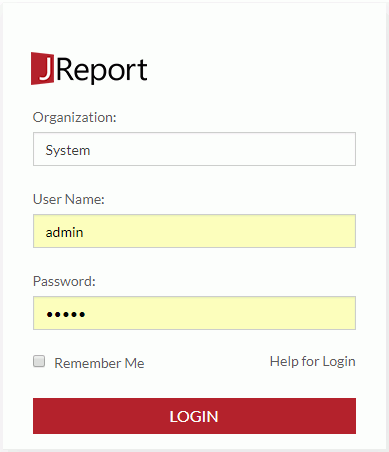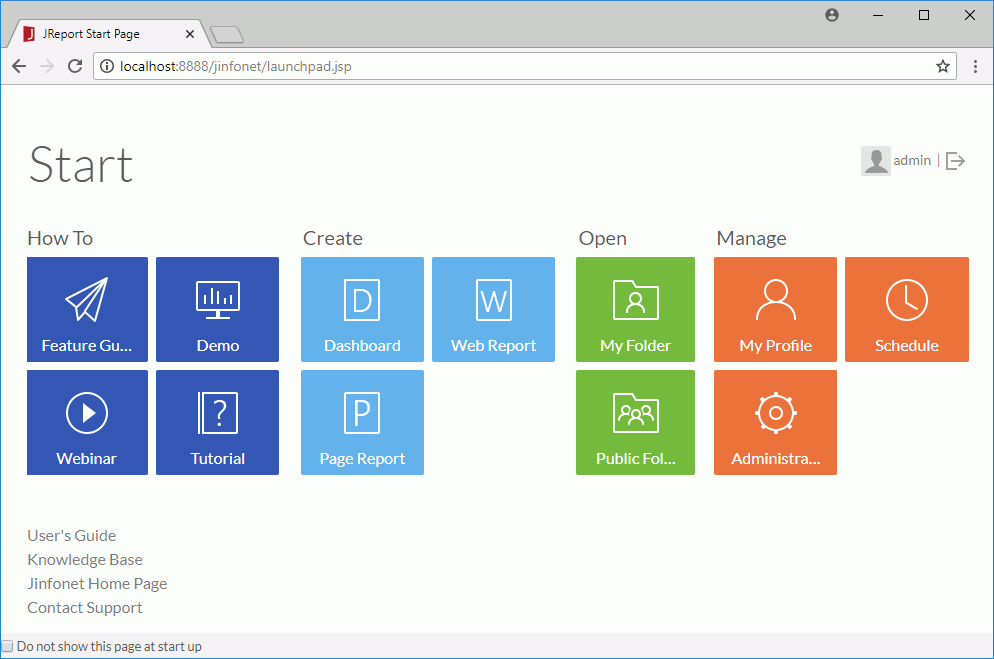 Previous Page Next Page
Previous Page Next Page
Logging onto the server console locally
Logging onto the server console by URL
JReport Server is accessible through a web browser such as Internet Explorer, Firefox, or Google Chrome. JReport Server console provides a unified UI for end users and administrators to access and manage server resources depending on authorization. End users can perform report related tasks such as running and creating reports and dashboards, starting visual analysis, customizing their own server preferences and so on. Administrators can perform administrative tasks such as managing security and databases, configuring the server, setting up cluster and so on.
To access the JReport Server console from the same machine on which JReport Server is installed, take the following steps:

The Start Page is the default home page of the JReport Server console. It provides quick entries to some key functions. Choose a topic to start your work on the server.

| Option | Description |
|---|---|
| How To | |
| Feature Guide | Displays the guide about JReport's main features. |
| Demo | Displays dashboards and reports demos. |
| Webinar | Goes to JReport webinar web page. |
| Tutorial | Displays the JReport Tutorial guide. |
| Create | |
| Dashboard | Creates a dashboard. |
| Web Report | Creates a web report. |
| Page Report | Creates a page report. |
| Open | |
| My Folder | Opens the My Reports folder in the JReport Server console. |
| Public Folder | Opens the Public Reports folder in the JReport Server console. |
| Manage | |
| My Profile | Opens the server console > My Profile > Customize Server Preferences page for configuring the server profile settings of your own. |
| Schedule | Schedules a task to run a report. |
| Administration | Opens the server console > Administration > Configuration > Advanced page for managing the server advanced resources. Available to administrators only. |
| Others | |
| User name | Shows the name of the current login user. |
 |
Logs out the server. |
| User's Guide | Displays the JReport Server User's Guide. |
| Knowledge Base | Goes to the JReport Knowledge Base to seek help. |
| Jinfonet Home Page | Goes to the Jinfonet Software Home Page. |
| Contact Support | Goes to JReport support center. |
| Do not show this page at start up | If checked, the JReport Server console home page will be changed from the Start Page to the server console when the server starts next time. You can display the Start Page by clicking the Start Page button  on the system toolbar of the server console. on the system toolbar of the server console. |
Sometimes you may have closed the Start Page or server console while the local server remains started, or you are accessing the server console from a remote computer, you can access it by URL as follows:
http://IP_or_HostName_or_DomainName:port (by default the port for accessing the server console is 8888).
If you don't know the IP address of the machine on which the server runs, and it is the same machine where you are going to log in, you can use localhost instead of the IP address. You can also open a console window such as telnet on the server machine and type hostname to get the name of the host.
JReport Server provides a special channel that automatically creates an extra user session for management purposes if the license limit of the maximum number of concurrent users has been reached. The extra user session cannot be used to run reports or submit schedules. It can only be used by admin users for performing management operations. If your JReport Server license has a bounded limit to the maximum number of concurrent users, this feature will take effect.
Only one extra valid user session can be created and used within this special channel at any time. If an extra user session has already been created and is still valid, your request for login will be prompted with a confirmation page asking you whether or not to close the existing extra user session. Only when the existing user session is closed can JReport Server start a new user session for you to perform management operations. Otherwise, you will not be allowed to log onto JReport Server.
To log out from JReport Server Start Page, click the  button at the upper right corner.
button at the upper right corner.
To log out from JReport Server console, point at the user name at the upper right corner and click Logout from the drop-down menu.